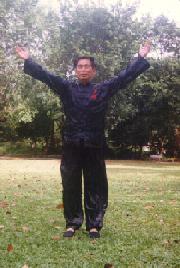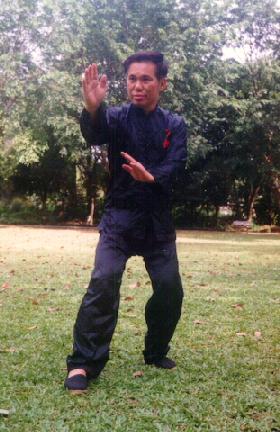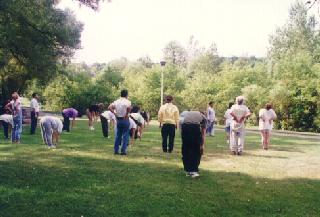SELECTION OF QUESTIONS AND ANSWERS
AUGUST 1999 PART 2

Sifu Wong tapping cosmic energy with a symmetrical zhan zhuang position known as "Embrcing the Cosmos"
Question 1
Thank you for your kindness in continuing to provide so much high quality information on Chi Kung and the Martial Arts through your Web Site. I would like to ask you some further questions on Zhan Zhuang. Some systems of Zhan Zhuang seem to make use of other positions in addition to the Three Circle Stance. For example I came across one method of training that included such positions as holding your hands up at about the level of your ears as though you were catching a large ball; holding out your arms horizontally to the sides as though you were trying to maintain your balance in a stream of water; and holding an imaginary balloon in front of the lower dan tien.
— Alan, UK
Answer
Zhan zhuang, which literally means stance-standing, is a generic term, referring to a category of chi kung exercises where a practitioner remains in a particular static position ranging generally from 3 to 60 minutes. The principal aim is to develop internal force, and it is a very effective method if the practitioner has the patient and endurance to practise daily for at least a hundred days. However, as the exercise looks simple, it is also easy to make mistakes which may result in adverse side-effects. Zhan zhuang therefore should be practised under the supervision of a master, or on their own only by experienced students.
There are many different zhan zhuang exercises. The most famous are the Horse-Riding Stance in Shaolin Kungfu, and the Three-Circle Stance in Taijiquan. Those zhan zhuang exercises mentioned by you are also widely practised. Holding your hands up at about the level of your ears as though you were catching a large ball is called "Embracing the Cosmos". Holding out your arms horizontally to the sides as though you were trying to maintain your balance in a stream of water is called "Carrying the Mountain". Holding an imaginary balloon in front of the lower dan tian is called "Holding the Dan Tian".
Besides these symmetrical positions, there are also asymmetrical positions used in zhan zhuang. Some examples are the "Three-Treasure Stance" (similar to the "Lifting up Hands" pattern in Taijiquan) in Xing Yi Kungfu, "Single Changing Palm" in Baguazhang, and various positions of standing on one leg in White Crane Kungfu.
The different zhan zhuang positions have different focus and emphasis. For a Taijiquan exponent, it is best to stick to the "Three-Circle Stance"; there is no need to change to other stances even when he has progressed to an advanced stage, although he can do so for some particular reasons. For a Xing Yi Kungfu exponent, it is best to practise the "Three-Treasure Stance", as this is the stance that he uses most of the time in his kungfu practice and application. For one who wishes to develop powerful arms, he can practise "Carrying the Mountain"; and one who wishes to take in cosmic energy, "Embracing the Cosmos".
It is a common mis-conception, even among many kungfu students, that zhan zhuang merely develops solid stances. This type of chi kung is probably the most important for developing internal force. It is a little known secret that while kungfu novices (no matter for how many years they may have learnt kungfu) spend their time chasing after new kungfu forms, kungfu masters doggedly train in their same zhan zhuang exercise year after year.
Question 2
You indicated previously that it would be a good idea to intersperse Zhan Zhuang with your own dynamic chi kung exercises once or twice a week. Is it preferable to practice say 5 days of Zhan Zhuang followed by 2 days of dynamic chi kung, or perhaps 2 - 3 days of Zhan Zhuang followed by 1 day of dynamic chi kung, repeated twice a week?
Answer
2-3 days of zhan zhuang followed by 1 day of dynamic chi kung is better. Later, say about 3 months, you can progress to 5-6 days of zhan zhuang followed by 1 day of dynamic chi kung.
At an advanced stage, you can practise zhan zhuang everyday, without having to intersperse with dynamic patterns.
Dynamic patterns are needed at the initial stage as a precaution to cleanse off adverse side-effects unwittingly developed from incorrect practice of zhan zhuang.
Question 3
I noticed in a previous answer given to another student that it was suggested combining 'Lifting the Sky' with Zhan Zhuang. Can this advice be adopted generally by other people practising Zhan Zhuang?
Answer
Yes, "Lifting the Sky" is an excellent dynamic pattern. It can be used in conjunction with any zhan zhuang exercise. Not only it will help to cleanse off adverse side-effects unwittingly obtained, "Lifting the Sky" can also enhance the good effects of zhan zhuang.
You can perform about 10 to 20 times of "Lifting the Sky" before zhan zhuang, and once a while, perform just "Lifting the Sky" (without zhan zhuang) about 20 to 30 times to cleanse off adverse side-effects. Of course you must perform "Lifting the Sky" as chi kung, and not as some gentle exercise.Question 4
Is Zhan Zhuang potentially dangerous because existing energy blockages can be made worse by the increased flow of energy? I can understand the idea that if an energy blockage is not dispersed by the increased flow of chi it could be made worse, similar to a partially blocked pipe becoming even more blocked up. I wondered if this analogy was correct.
Answer
I would not single out zhan zhaung as potentially dangerous; any chi kung exercise if done wrongly would bring adverse effects. But it is true that existing energy blockage will be made worse by an increased flow of energy, and the risk in zhan zhuang is both more likely as well as more serious than most other chi kung exercises.
Your analogy of a blocked pipe is useful, but not exact. A blocked pipe may cause the pipe to burst, but a blocked meridian (or energy pathway) doesn't because a meridain does not have a fixed boundary. However, the effects can be very serious.
The blocked energy on one side of the blockage pressurizes on surrounding tissues and organs causing internal injury, on the other side there is insufficient energy flow to work the body systems. Moreover the blockage distorts the body energy network with far-reaching consequences.
Sifu Wong demonstrating an asymmetrical zhan Zhuang position known as the "Three-Treasure Stance", which is a popular zhan zhuang exercise amongs various internal kungfu styles, especially Xing Yi Kungfu
Question 5
If a student is training on his or her own in Zhan Zhuang is there a maximum sensible time to stand each day?
Answer
It depends on numerous factors, but as a rough guide 5 minutes is a sensible maximum time for a beginner.
Question 6
If you are practising Three-Circle Stance on a regular basis and you are a martial artist would supplementary training in Golden Bridge be a good idea or should they always be kept separate?
Answer
Generally they should be kept separate because their good effects may negate each other. The Three-Circle Stance emphasizes on qi (chi) whereas the Golden Bridge emphasizes on jing.
Qi is vital energy, whereas jing is essence, which may be translated as sub-atomic particles in Western terms. In Three-Circle Stance the exponent becomes powerful as a result of better internal energy flow; in Golden Bridge it is because the sub-atomic particles which form the tissues of the muscles have been strengthened.Question 7
What basic exercises should be safe for me to practice on my own, with the help of books. Would Embracing the Moon, Holding Up Heaven and Golden Bridge be alright?
Answer
"Carrying the Moon" and "Lifting the Sky" (which are the terms I use in my books for the patterns that in Chinese may be literally translated into "Embracing the Moon" and "Holding Up Heaven") are comparatively safe to be done on your own if you perform them at the physical level. You may regulate your breathing as described in the book but you must do so gently and do not pay too much attention to it. For example, just breathe in and out gently as mentioned but do not worry unduly about whether you are doing it perfectly. Leave the mind dimension aside; do not, for example, attempt visualization.
Your result when you practise on your own from books is definitely vastly different from that when you learn personally from a master. This is to be expected; it is a manifestation of stubbornness or arrogance when people think that they, without any experience, could produce the same result as a master.
It is also utterly unwise if they think they are smarter than the master and ignore his advice or warning. For example, in my books, I have warned that beginners should not attempt advanced chi kung exercises like Abdominal Breathing and Cosmos Breathing on their own, and that they should leave out the visualization part in those exercises that they can practise on their own. Yet, some beginners attempt Abdominal Breathing and visualization.
It is not advisable to practise Golden Bridge without a master's supervision. This exercise looks simple, but may cause serious insidious damage if performed incorrectly.
Question 8
Correct me if I'm wrong, but is Embracing the Moon the stance where you put 95% of your weight on one leg and place the other leg forward while tiptoeing, with your arms in a horizontal circle, and tip of fingers not touching with your tongue on the roof of your mouth? Are you supposed to visualize energy flowing from your shoulders out and crossing on the exhale and then coming back to shoulders on the inhale?
Answer
No, your interpretation is totally wrong. The weight is even on both feet, and they are placed standing together or very slightly apart, and the whole feet are firmly on the ground. Do not worry about your tongue, and do not worry about visualizing your energy flow if you practise on your own. If you practise this pattern according to the way you have described, you are very likely to develop serious problems.
The movement for this exercise is comparatively simple. Yet despite the clear explanation and illustration in my books, you have interpreted it so differently, and adversely. This is a good example showing that if one wishes to have good result in chi kung, he (or she) should learn personally from a master.
Question 9
Is Holding Up Heaven the stance where you bring your arms up while breathing, then down with your whole body while exhaling to a similar to squatting position, thighs horizontal, then look up with hands moving up too while inhaling, and exhaling while moving into the final position for holding up heaven, with legs similar to horse stance, except slightly more than shoulder width? Are you supposed to visualize energy flowing in through the top of your head on the inhale? And out to the heavens on the exhale?
Answer
Again your interpretation is totally wrong. Perform the exercise as it is described. Do not attempt to be starter than the masters who have throughout the centuries perfected this wonderful exercise and passed it on to us as a legacy.
This exercise has been always practised in a up-right standing position; if it were better in the horse-riding stance, the masters would have recommended it. Again, if you perform the exercise in the way you have described it, you are likely to have adverse side-effects.
All real chi kung includes meditation
Question 10
How about Golden Bridge? Is it the stance where you are "sitting" on a horse in a horse stance with thighs nearly horizontal and shins vertical, with 2 arms held parallel forward in the One Finger Zen form? Are you supposed to visualize any "qi"?
Answer
Yes, the position you have described is correct. Beginners should not attempt any visualization, but advanced practitioners may visualize qi in various ways according to their needs and purposes. This exercise should be practised under the supervision of a master or at least a competent instructor.
Question 11
Also, there should not be any pain or problems from doing these, right? If I happen to get any pain or problems, do I stop immediately?
Answer
Pain can be, for the sake of convenience, classified into "good pain" and "bad pain". Literally everyone practising the Golden Bridge will experience pain and problems. If the pain is "good" he should continue, if it is "bad" he should follow whatever advice the master may give.
One common problem is students tensing their body after a few minutes of training. A master will not just tell but actually help the students to relax their body; an inexperienced instructor or someone practising on his own may not even notice the problem, and practising in this way will cause energy blockage in his chest.Question 12
I have also read about the "3 gates". What exactly are these and how do you go about unblocking them? Am I correct to say that it is not safe to attempt to do this without a master to guide you, right?
Answer
The "three gates" refer to the three energy points of "ming men", "ling tai" and "bai hui" along the "du mai" or "governing meridian" which runs along the back of a person. There are many ways to open or unblock them, such as taking appropriate herbs, doing suitable exercises, using chi flow or using visualization.
A master can open these points on another person by merely placing his finger on them. This of course must be performed by a master; an inexperienced person may close instead of open them, and cause serious problems.Question 13
I have recently began meditation practice. I am wondering whether I can expect the same benefits from sitting meditation that are gained from chi kung. Is one better than the other?
— Allan, USA
Answer
All real chi kung includes mediation, though not necessarily in the cross-legged or lotus positions. Incidentally, if you merely sit cross-legged or in a lotus position, it does not necessarily mean you are doing meditation. Meditation means training the mind to attain deeper levels of consciousness.
Attaining "a chi kung state of mind", which is at a deeper level of consciousness than ordinary waking consciousness, is a necessary first step in any real chi kung practice. In other words, if one does not enter into a chi kung state of mind, which is called "entering silence" in classical terms, he cannot have real chi kung effects even though he may be doing some chi kung external forms or breathing exercise. This in fact is the common situation among most people who say they practise chi kung; actually they are merely performing external chi kung forms without the essence of chi kung.
Hence, when you practise chi kung -- real chi kung -- you are getting the benefits of energy training as well as mind training, whereas in meditation the emphasis is on mind training. This means you get more from chi kung, but it does not necessarily mean chi kung is better. If you are already healthy and full of vitality, the effect of which you can obtain more readily from practising chi kung, you may wish to progress to mind expansion and spiritual joy, which can be more readily obtained from meditation. But if you are still weak and sickly, you would probably be wasting your time in meditation, for not only you could not train your mind effectively, you would be troubling your mind with wandering thoughts while sitting cross-legged or in a lotus position.
Question 14
I saw a television program where a chi master knocked over a much larger man merely by placing his hand on him and supposedly emitting his chi. Is this really possibly? What other extraordinary products of meditation practice are possible?
Answer
Yes, what you saw on television is possible.
As meditation is the training of mind, when one's mind is highly trained, many seemingly impossible things are possible. Meditation and chi kung masters can, for example, materialize a castle or burn a hole in your coat by merely looking at it. You will probably find these extraordinary products of meditation hard to believe.
If you want some personal experiences and trust my words, you can read about my own chi kung experience on seeing the structure of air and stopping rain. If you read my book "The Art of Chi Kung", you can read about some extraordinary abilities of my disciples, like reading somebody's mind and moving people without touching them.
Nevertheless, while these feats are incredibly remarkable, they are not the main purpose why we practise chi kung or meditation -- to do so is an unwise use of time. The main purpose of chi kung and meditation practice is to attain good health, vitality, mind expansion and spiritual joy.
